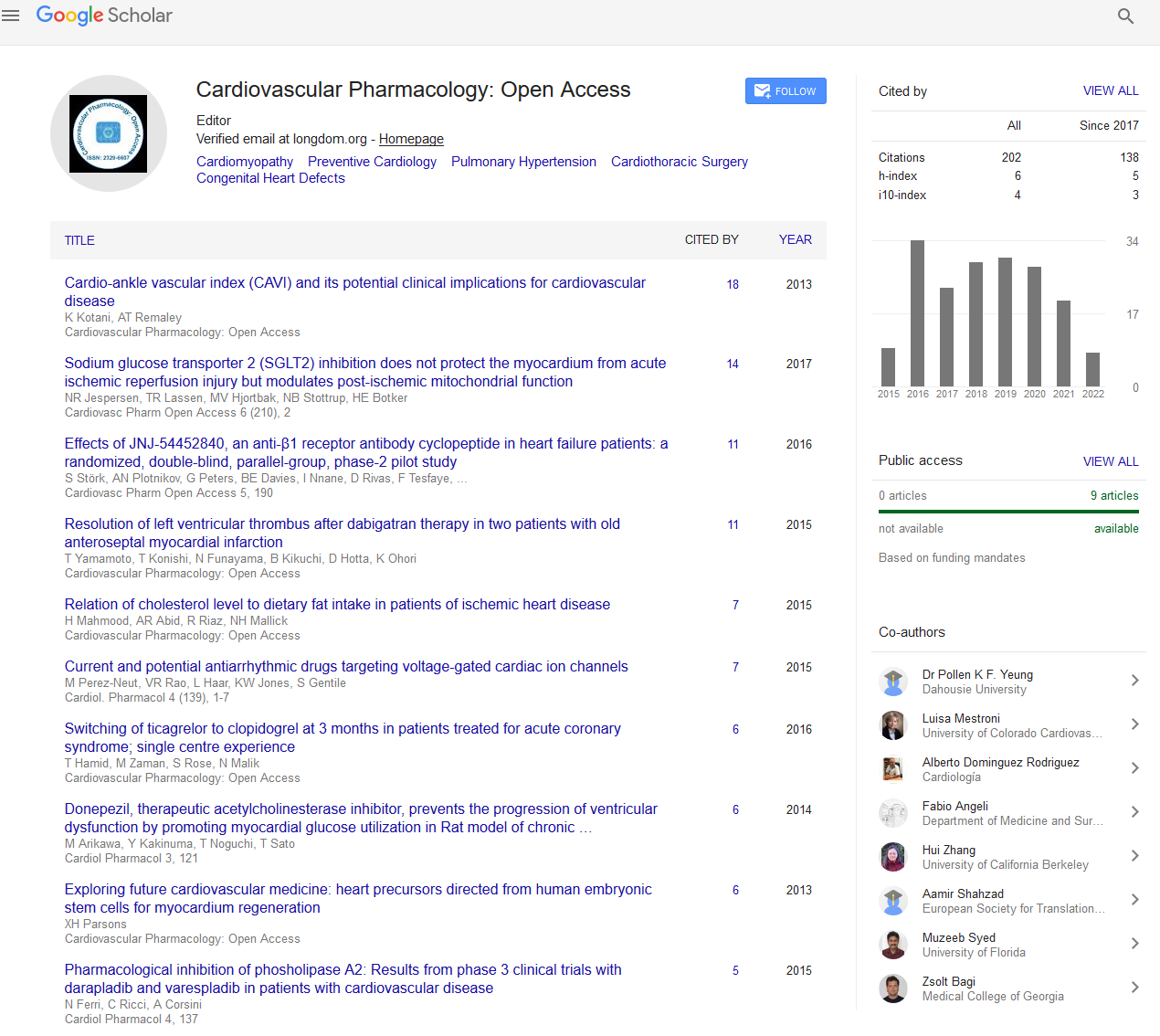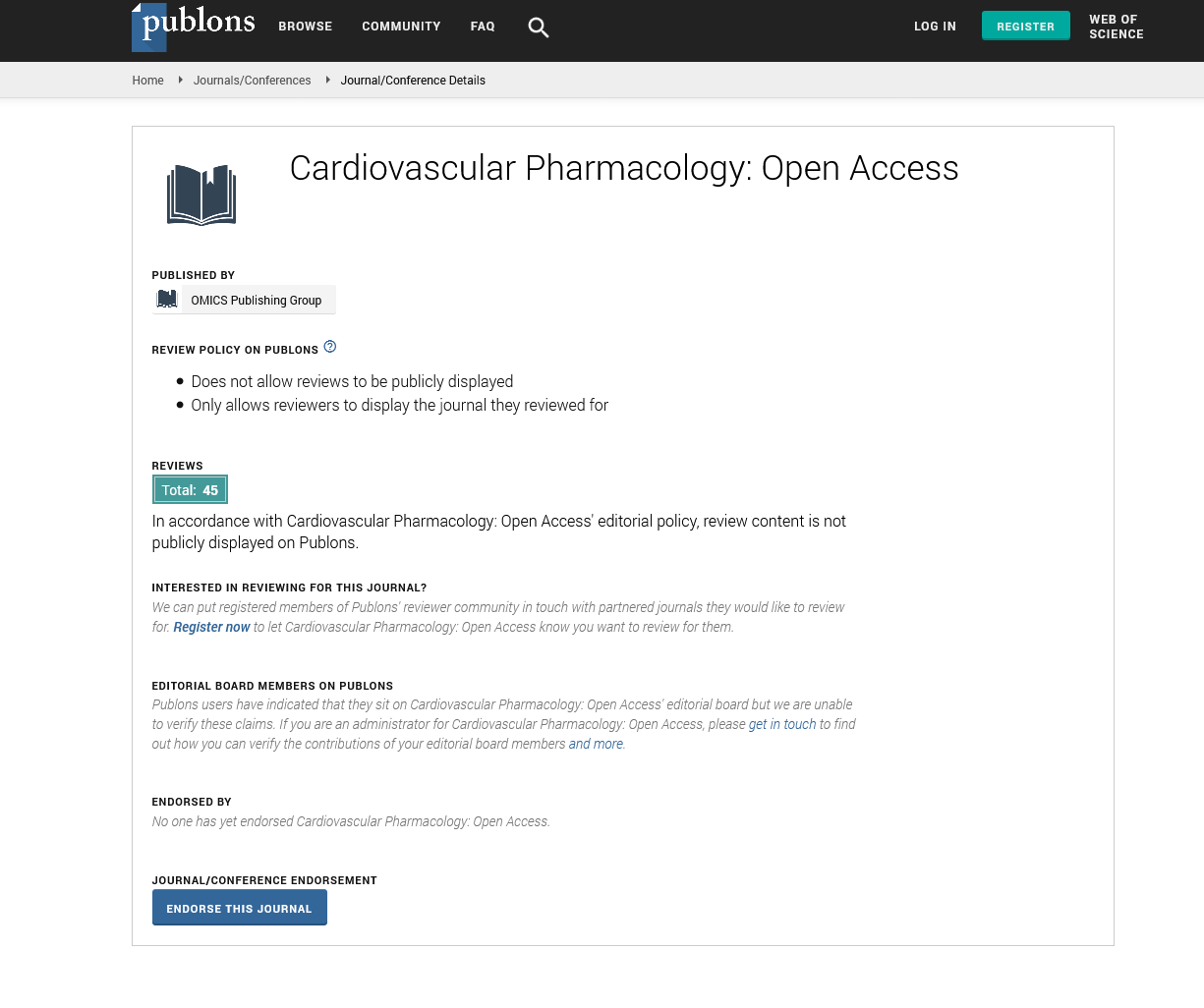Indexed In
- Open J Gate
- Cosmos IF
- RefSeek
- Hamdard University
- EBSCO A-Z
- OCLC- WorldCat
- Publons
- Geneva Foundation for Medical Education and Research
- Euro Pub
- Google Scholar
Useful Links
Share This Page
Journal Flyer

Open Access Journals
- Agri and Aquaculture
- Biochemistry
- Bioinformatics & Systems Biology
- Business & Management
- Chemistry
- Clinical Sciences
- Engineering
- Food & Nutrition
- General Science
- Genetics & Molecular Biology
- Immunology & Microbiology
- Medical Sciences
- Neuroscience & Psychology
- Nursing & Health Care
- Pharmaceutical Sciences
Short Communication - (2025) Volume 14, Issue 2
Advances in Antiplatelet Therapy for Secondary Prevention of Myocardial Infarction
Hiroshi Tanaka*Received: 29-May-2025, Manuscript No. CPO-25-29828; Editor assigned: 31-May-2025, Pre QC No. CPO-25-29828; Reviewed: 14-Jun-2025, QC No. CPO-25-29828; Revised: 20-Jun-2025, Manuscript No. CPO-25-29828; Published: 28-Jun-2025, DOI: 10.35248/2329-6607.25.14.425
Description
Antiplatelet therapy has played an indispensable role in the secondary prevention of myocardial infarction. The pathophysiological process leading to myocardial infarction is strongly linked to platelet activation and aggregation at the site of a ruptured atherosclerotic plaque. By interfering with platelet function antiplatelet drugs prevent recurrent occlusive events and reduce mortality. Aspirin remains the most extensively studied drug in this category and its effect on cyclooxygenase inhibition and thromboxane A2 suppression has been responsible for significant reductions in recurrent cardiac events [1]. Clopidogrel and its class of P2Y12 receptor antagonists have added substantial value by targeting a different mechanism of platelet activation. When used in dual antiplatelet therapy alongside aspirin clopidogrel or newer agents such as prasugrel and ticagrelor significantly decrease the rate of stent thrombosis and recurrent myocardial infarction. Comparative trials have shown that ticagrelor offers more rapid and consistent platelet inhibition than clopidogrel which translates into reduced ischemic complications though often at the cost of higher bleeding risk [2].
The clinical decision regarding antiplatelet therapy involves weighing ischemic protection against hemorrhagic complications. Certain populations such as elderly patients or those with gastrointestinal disorders require individualized regimens. Proton pump inhibitors are frequently coadministered to mitigate gastrointestinal bleeding without altering the effectiveness of platelet inhibition. The advent of genetic testing has also highlighted variations in drug response. For instance, patients carrying loss-of-function alleles of CYP2C19 may show inadequate response to clopidogrel which has prompted clinicians to prefer ticagrelor or prasugrel in such cases. Duration of dual antiplatelet therapy is another critical consideration. While long-term therapy reduces the risk of late stent thrombosis it also increases bleeding risk. Recent evidence has favored shorter durations in low-risk patients particularly those with newer generation drug-eluting stents. At the same time extended therapy may be considered in high-risk groups such as patients with diabetes multivessel disease or prior stent thrombosis [3].
The expanding use of novel drug delivery technologies including polymer-free stents and bioresorbable scaffolds may influence the future of antiplatelet therapy. Such devices may allow clinicians to minimize drug exposure while maintaining vascular healing. Ongoing research continues to focus on striking the ideal balance between safety and efficacy ensuring that therapy decisions remain dynamic and evidence-driven [4]. The broad impact of antiplatelet therapy in the reduction of recurrent myocardial infarction demonstrates its importance in cardiovascular pharmacology. While aspirin continues to be universally prescribed the availability of more potent agents provides clinicians with multiple tools to tailor therapy to the patient’s risk profile. With continuous research and refinement antiplatelet therapy is expected to remain a central strategy in reducing the global burden of ischemic heart disease [5].
Beyond the established agents and strategies, ongoing advancements in the field of antiplatelet therapy are exploring novel pathways and personalized medicine approaches to further enhance patient outcomes. One promising area of development involves the identification of biomarkers that can predict individual responses to specific antiplatelet drugs. This precision medicine approach aims to optimize therapy by tailoring treatment regimens not only based on clinical risk factors but also on genetic, biochemical and platelet function testing [6]. For example, platelet function assays that measure residual platelet reactivity while on treatment can guide clinicians in adjusting therapy intensity, potentially reducing both thrombotic and bleeding complications. In addition to genetic polymorphisms such as CYP2C19 variants affecting clopidogrel metabolism, other genetic markers influencing platelet reactivity and drug metabolism are under investigation. Understanding these complex genetic interactions could enable the design of genotype-guided algorithms to select the most effective and safest antiplatelet regimen for each patient, minimizing trial-and-error approaches [7].
Moreover, the expanding role of antiplatelet therapy in conjunction with emerging interventional cardiology techniques is shaping new treatment paradigms. For instance, in patients undergoing complex Percutaneous Coronary Interventions (PCI) with high thrombotic risk features such as bifurcation lesions or chronic total occlusions the intensity and duration of Dual Antiplatelet Therapy (DAPT) must be carefully balanced to prevent ischemic events without precipitating excessive bleeding [8]. This has led to interest in more flexible DAPT protocols and the potential integration of platelet function monitoring to individualize therapy duration. Furthermore, the landscape of antiplatelet therapy is evolving with the introduction of novel agents targeting alternative platelet activation pathways, such as thrombin receptor antagonists and inhibitors of other purinergic receptors beyond P2Y12. These new drugs offer the potential to provide potent platelet inhibition with possibly lower bleeding risks, though further clinical trials are required to define their role in routine practice [9].
Finally, patient adherence and real-world application remain critical challenges. The effectiveness of any antiplatelet regimen is contingent upon patients consistently taking their medications as prescribed. Strategies to improve adherence including patient education, simplified dosing schedules and addressing socioeconomic barriers are essential components of comprehensive cardiovascular care. In conclusion, while aspirin and P2Y12 inhibitors remain foundational to secondary prevention in myocardial infarction, the future of antiplatelet therapy lies in precision medicine, novel pharmacologic agents and integrative clinical approaches that prioritize both efficacy and safety. These advances promise to refine and personalize treatment, ultimately reducing the global impact of ischemic heart disease more effectively [10].
References
- Martin NK, Domínguez-Robles J, Stewart SA, Cornelius VA, Anjani QK, Utomo E, et al. Fused deposition modelling for the development of drug loaded cardiovascular prosthesis. Int J Pharm. 2021;595:120243.
[Crossref] [Google Scholar] [PubMed]
- Acierno D, Patti A. Fused Deposition Modelling (FDM) of thermoplastic-based filaments: Process and rheological properties-An overview. Materials. 2023;16(24):7664.
[Crossref] [Google Scholar] [PubMed]
- Goldstein DJ, Puskas JD, Alexander JH, Chang HL, Gammie JS, Marks ME, et al. External support for saphenous vein grafts in coronary artery bypass surgery: A randomized clinical trial. JAMA Cardiol. 2022;7(8):808-16.
[Crossref] [Google Scholar] [PubMed]
- Mishra GP, Nguyen D, Alani AW. Inhibitory effect of paclitaxel and rapamycin individual and dual drug-loaded polymeric micelles in the angiogenic cascade. Mol Pharm. 2013;10(5):2071-8.
[Crossref] [Google Scholar] [PubMed]
- Welten GM, Schouten O, Hoeks SE, Chonchol M, Vidakovic R, van Domburg RT, et al. Long-term prognosis of patients with peripheral arterial disease: A comparison in patients with coronary artery disease. J Am Coll Cardiol. 2008;22;51(16):1588-96.
[Crossref] [Google Scholar] [PubMed]
- Zhang J, Yang W, Vo AQ, Feng X, Ye X, Kim DW, et al. Hydroxypropyl methylcellulose-based controlled release dosage by melt extrusion and 3D printing: Structure and drug release correlation. Carbohydr Polym. 2017;177:49-57.
[Crossref] [Google Scholar] [PubMed]
- Luzuriaga MA, Berry DR, Reagan JC, Smaldone RA, Gassensmith JJ. Biodegradable 3D printed polymer microneedles for transdermal drug delivery. Lab Chip. 2018;18(8):1223-30.
[Crossref] [Google Scholar] [PubMed]
- Korei N, Solouk A, Nazarpak MH, Nouri A. A review on design characteristics and fabrication methods of metallic cardiovascular stents. Materials Today Communications. 2022;31:103467.
- Albert NM, Paul S, Murray M. Complexities of care for patients and families living with advanced cardiovascular diseases: Overview. J Cardiovasc Nurs. 2012;27(2):103-13.
[Crossref] [Google Scholar] [PubMed]
- Martin NK, Domínguez-Robles J, Stewart SA, Cornelius VA, Anjani QK, Utomo E, et al. Fused deposition modelling for the development of drug loaded cardiovascular prosthesis. Int J Pharm. 2021;595:120243.
[Crossref] [Google Scholar] [PubMed]
Citation: Tanaka H (2025). Advances in Antiplatelet Therapy for Secondary Prevention of Myocardial Infarction. 14:425.
Copyright: © 2025 Tanaka H. This is an open-access article distributed under the terms of the Creative Commons Attribution License, which permits unrestricted use, distribution and reproduction in any medium, provided the original author and source are credited.


